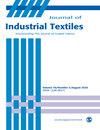Development of a hand classification system for smart hand wearables
IF 2
4区 工程技术
Q1 MATERIALS SCIENCE, TEXTILES
引用次数: 1
Abstract
Research purpose: This study aimed to lay a research foundation for smart hand wearable design by classifying the right-hand data of 4545 adults aged 20 to 69. Further, to increase the practical applicability of the hand classification system, a hand type discrimination method and regression equations for the hand dimensions of each type were presented. Methods: This study statistically analyzed eighth Size Korea data with IBM SPSS Ver.26.0. Cluster analysis was performed to classify both finger length and circumference type. Discriminant analysis was conducted, yielding discriminant functions to aid potential smart hand wearable wearers in self-diagnosing their hand types. Linear regression analysis yielded regression equations for the detailed finger dimensions for the pattern-making of smart hand wearables. Results: The finger length type was categorized into four types: the Uphill type, Downhill type, Mountain type, and Horizon type for both men’s and women’s hands. The finger circumference type was categorized into two types, the Cone and Cylinder types, for both men’s and women’s hands. The discriminant function showed a mean accuracy rate of 89.9% and the regression equations a mean explanatory power of 72.9%. Conclusion: The hand classification system proposed in this study aimed to improve the fingertip fit of smart hand wearable products by analyzing the configuration of motion tracking gloves or haptic gloves. In addition, considering the practical applicability for both wearers and designers of smart hand wearables, a discrimination method of finger types for wearers’ self-diagnosis and regression functions of finger dimensions for designers’ pattern making were provided.智能手穿戴设备手部分类系统的开发
研究目的:本研究通过对4545名20 - 69岁成年人右手数据进行分类,为智能手穿戴设计奠定研究基础。为了提高手型分类系统的实用性,提出了手型判别方法和各手型尺寸的回归方程。方法:本研究采用IBM SPSS Ver.26.0软件对八级韩国数据进行统计分析。采用聚类分析对手指长度和围度进行分类。进行判别分析,得到判别函数,帮助潜在的智能手穿戴者自我诊断自己的手型。线性回归分析得到了智能手穿戴式制模的详细手指尺寸回归方程。结果:男性和女性手指长度类型均分为上坡型、下坡型、山地型和地平线型4种类型。男性和女性的手指周长类型分为两种类型,锥型和圆柱形。判别函数的平均准确率为89.9%,回归方程的平均解释力为72.9%。结论:本研究提出的手部分类系统,旨在通过分析运动追踪手套或触觉手套的配置,提高智能手穿戴产品的指尖贴合度。此外,考虑到智能手穿戴设备对佩戴者和设计师的实用性,提供了一种用于佩戴者自我诊断的手指类型判别方法和用于设计师图案制作的手指尺寸回归函数。
本文章由计算机程序翻译,如有差异,请以英文原文为准。
求助全文
约1分钟内获得全文
求助全文
来源期刊

Journal of Industrial Textiles
MATERIALS SCIENCE, TEXTILES-
CiteScore
5.30
自引率
18.80%
发文量
165
审稿时长
2.3 months
期刊介绍:
The Journal of Industrial Textiles is the only peer reviewed journal devoted exclusively to technology, processing, methodology, modelling and applications in technical textiles, nonwovens, coated and laminated fabrics, textile composites and nanofibers.
 求助内容:
求助内容: 应助结果提醒方式:
应助结果提醒方式:


